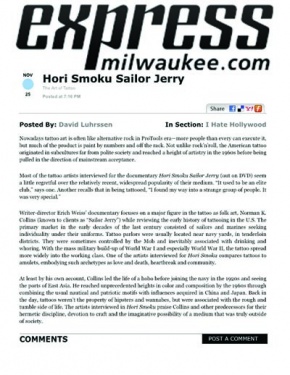News
Review on Express Milwaukee.com
11/25/09
Express Milwaukee.com

Hori Smoku Sailor Jerry
Posted By: David Luhrssen
Nowadays tattoo art is often like alternative rock in ProTools era—more people than every can execute it, but much of the product is paint by numbers and off the rack. Not unlike rock’n’roll, the American tattoo originated in subcultures far from polite society and reached a height of artistry in the 1960s before being pulled in the direction of mainstream acceptance.
Most of the tattoo artists interviewed for the documentary Hori Smoku Sailor Jerry (out on DVD) seem a little regretful over the relatively recent, widespread popularity of their medium. “It used to be an elite club,” says one. Another recalls that in being tattooed, “I found my way into a strange group of people. It was very special.”
Writer-director Erich Weiss’ documentary focuses on a major figure in the tattoo as folk art, Norman K. Collins (known to clients as “Sailor Jerry”) while reviewing the early history of tattooing in the U.S. The primary market in the early decades of the last century consisted of sailors and marines seeking individuality under their uniforms. Tattoo parlors were usually located near navy yards, in tenderloin districts. They were sometimes controlled by the Mob and inevitably associated with drinking and whoring. With the mass military build-up of World War I and especially World War II, the tattoo spread more widely into the working class. One of the artists interviewed for Hori Smoku compares tattoos to amulets, embodying such archetypes as love and death, heartbreak and community.
At least by his own account, Collins led the life of a hobo before joining the navy in the 1920s and seeing the ports of East Asia. He reached unprecedented heights in color and composition by the 1960s through combining the usual nautical and patriotic motifs with influences acquired in China and Japan. Back in the day, tattoos weren’t the property of hipsters and wannabes, but were associated with the rough and tumble side of life. The artists interviewed in Hori Smoku praise Collins and other predecessors for their hermetic discipline, devotion to craft and the imaginative possibility of a medium that was truly outside of society.
